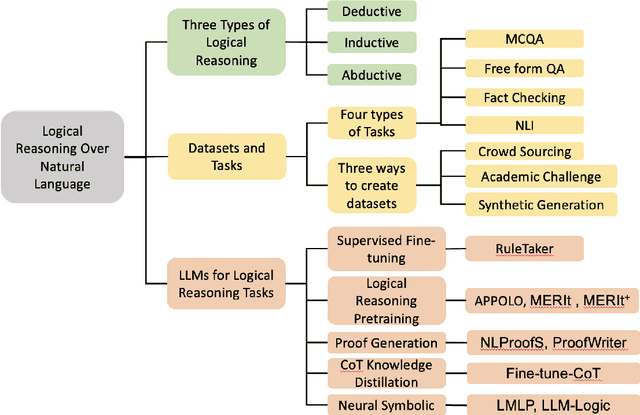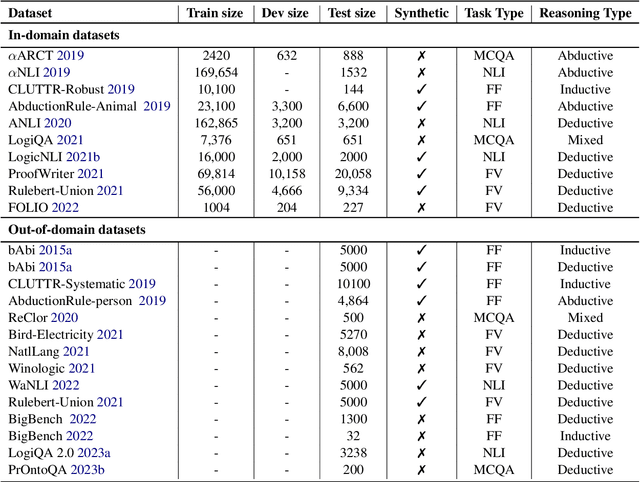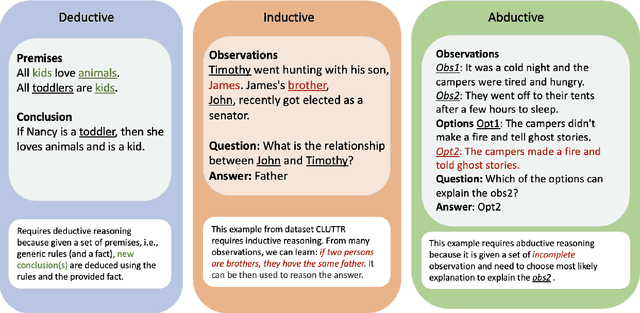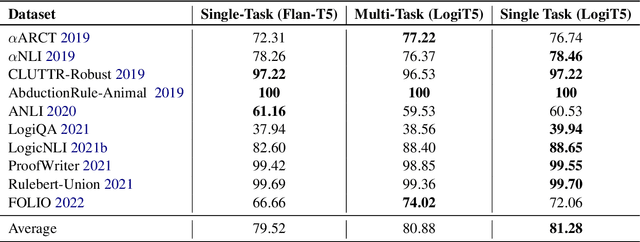Neeraj Varshney
Stabilizing Reinforcement Learning for Honesty Alignment in Language Models on Deductive Reasoning
Nov 12, 2025Abstract:Reinforcement learning with verifiable rewards (RLVR) has recently emerged as a promising framework for aligning language models with complex reasoning objectives. However, most existing methods optimize only for final task outcomes, leaving models vulnerable to collapse when negative rewards dominate early training. This challenge is especially pronounced in honesty alignment, where models must not only solve answerable queries but also identify when conclusions cannot be drawn from the given premises. Deductive reasoning provides an ideal testbed because it isolates reasoning capability from reliance on external factual knowledge. To investigate honesty alignment, we curate two multi-step deductive reasoning datasets from graph structures, one for linear algebra and one for logical inference, and introduce unanswerable cases by randomly perturbing an edge in half of the instances. We find that GRPO, with or without supervised fine tuning initialization, struggles on these tasks. Through extensive experiments across three models, we evaluate stabilization strategies and show that curriculum learning provides some benefit but requires carefully designed in distribution datasets with controllable difficulty. To address these limitations, we propose Anchor, a reinforcement learning method that injects ground truth trajectories into rollouts, preventing early training collapse. Our results demonstrate that this method stabilizes learning and significantly improves the overall reasoning performance, underscoring the importance of training dynamics for enabling reliable deductive reasoning in aligned language models.
Deep Learning-based Human Gesture Channel Modeling for Integrated Sensing and Communication Scenarios
Jul 09, 2025Abstract:With the development of Integrated Sensing and Communication (ISAC) for Sixth-Generation (6G) wireless systems, contactless human recognition has emerged as one of the key application scenarios. Since human gesture motion induces subtle and random variations in wireless multipath propagation, how to accurately model human gesture channels has become a crucial issue for the design and validation of ISAC systems. To this end, this paper proposes a deep learning-based human gesture channel modeling framework for ISAC scenarios, in which the human body is decomposed into multiple body parts, and the mapping between human gestures and their corresponding multipath characteristics is learned from real-world measurements. Specifically, a Poisson neural network is employed to predict the number of Multi-Path Components (MPCs) for each human body part, while Conditional Variational Auto-Encoders (C-VAEs) are reused to generate the scattering points, which are further used to reconstruct continuous channel impulse responses and micro-Doppler signatures. Simulation results demonstrate that the proposed method achieves high accuracy and generalization across different gestures and subjects, providing an interpretable approach for data augmentation and the evaluation of gesture-based ISAC systems.
Multi-LogiEval: Towards Evaluating Multi-Step Logical Reasoning Ability of Large Language Models
Jun 24, 2024



Abstract:As Large Language Models (LLMs) continue to exhibit remarkable performance in natural language understanding tasks, there is a crucial need to measure their ability for human-like multi-step logical reasoning. Existing logical reasoning evaluation benchmarks often focus primarily on simplistic single-step or multi-step reasoning with a limited set of inference rules. Furthermore, the lack of datasets for evaluating non-monotonic reasoning represents a crucial gap since it aligns more closely with human-like reasoning. To address these limitations, we propose Multi-LogiEval, a comprehensive evaluation dataset encompassing multi-step logical reasoning with various inference rules and depths. Multi-LogiEval covers three logic types--propositional, first-order, and non-monotonic--consisting of more than 30 inference rules and more than 60 of their combinations with various depths. Leveraging this dataset, we conduct evaluations on a range of LLMs including GPT-4, ChatGPT, Gemini-Pro, Yi, Orca, and Mistral, employing a zero-shot chain-of-thought. Experimental results show that there is a significant drop in the performance of LLMs as the reasoning steps/depth increases (average accuracy of ~68% at depth-1 to ~43% at depth-5). We further conduct a thorough investigation of reasoning chains generated by LLMs which reveals several important findings. We believe that Multi-LogiEval facilitates future research for evaluating and enhancing the logical reasoning ability of LLMs. Data is available at https://github.com/Mihir3009/Multi-LogiEval.
Efficient Transmission Scheme for LEO Satellite-Based NB-IoT: A Data-Driven Perspective
Jun 20, 2024Abstract:This study analyses the medium access control (MAC) layer aspects of a low-Earth-orbit (LEO) satellite-based Internet of Things (IoT) network. A transmission scheme based on change detection is proposed to accommodate more users within the network and improve energy efficiency. Machine learning (ML) algorithms are also proposed to reduce the payload size by leveraging the correlation among the sensed parameters. Real-world data from an IoT testbed deployed for a smart city application is utilised to analyse the performance regarding collision probability, effective data received and average battery lifetime. The findings reveal that the traffic pattern, post-implementation of the proposed scheme, differs from the commonly assumed Poisson traffic, thus proving the effectiveness of having IoT data from actual deployment. It is demonstrated that the transmission scheme facilitates accommodating more devices while targeting a specific collision probability. Considering the link budget for a direct access NB-IoT scenario, more data is effectively offloaded to the server within the limited visibility of LEO satellites. The average battery lifetimes are also demonstrated to increase by many folds by using the proposed access schemes and ML algorithms.
Investigating and Addressing Hallucinations of LLMs in Tasks Involving Negation
Jun 08, 2024Abstract:Large Language Models (LLMs) have achieved remarkable performance across a wide variety of natural language tasks. However, they have been shown to suffer from a critical limitation pertinent to 'hallucination' in their output. Recent research has focused on investigating and addressing this problem for a variety of tasks such as biography generation, question answering, abstractive summarization, and dialogue generation. However, the crucial aspect pertaining to 'negation' has remained considerably underexplored. Negation is important because it adds depth and nuance to the understanding of language and is also crucial for logical reasoning and inference. In this work, we address the above limitation and particularly focus on studying the impact of negation in LLM hallucinations. Specifically, we study four tasks with negation: 'false premise completion', 'constrained fact generation', 'multiple choice question answering', and 'fact generation'. We show that open-source state-of-the-art LLMs such as LLaMA-2-chat, Vicuna, and Orca-2 hallucinate considerably on all these tasks involving negation which underlines a critical shortcoming of these models. Addressing this problem, we further study numerous strategies to mitigate these hallucinations and demonstrate their impact.
Chaos with Keywords: Exposing Large Language Models Sycophancy to Misleading Keywords and Evaluating Defense Strategies
Jun 06, 2024Abstract:This study explores the sycophantic tendencies of Large Language Models (LLMs), where these models tend to provide answers that match what users want to hear, even if they are not entirely correct. The motivation behind this exploration stems from the common behavior observed in individuals searching the internet for facts with partial or misleading knowledge. Similar to using web search engines, users may recall fragments of misleading keywords and submit them to an LLM, hoping for a comprehensive response. Our empirical analysis of several LLMs shows the potential danger of these models amplifying misinformation when presented with misleading keywords. Additionally, we thoroughly assess four existing hallucination mitigation strategies to reduce LLMs sycophantic behavior. Our experiments demonstrate the effectiveness of these strategies for generating factually correct statements. Furthermore, our analyses delve into knowledge-probing experiments on factual keywords and different categories of sycophancy mitigation.
Towards Systematic Evaluation of Logical Reasoning Ability of Large Language Models
Apr 23, 2024Abstract:Recently developed large language models (LLMs) have been shown to perform remarkably well on a wide range of language understanding tasks. But, can they really "reason" over the natural language? This question has been receiving significant research attention and many reasoning skills such as commonsense, numerical, and qualitative have been studied. However, the crucial skill pertaining to 'logical reasoning' has remained underexplored. Existing work investigating this reasoning ability of LLMs has focused only on a couple of inference rules (such as modus ponens and modus tollens) of propositional and first-order logic. Addressing the above limitation, we comprehensively evaluate the logical reasoning ability of LLMs on 25 different reasoning patterns spanning over propositional, first-order, and non-monotonic logics. To enable systematic evaluation, we introduce LogicBench, a natural language question-answering dataset focusing on the use of a single inference rule. We conduct detailed analysis with a range of LLMs such as GPT-4, ChatGPT, Gemini, Llama-2, and Mistral using chain-of-thought prompting. Experimental results show that existing LLMs do not fare well on LogicBench; especially, they struggle with instances involving complex reasoning and negations. Furthermore, they sometimes overlook contextual information necessary for reasoning to arrive at the correct conclusion. We believe that our work and findings facilitate future research for evaluating and enhancing the logical reasoning ability of LLMs. Data and code are available at https://github.com/Mihir3009/LogicBench.
The Art of Defending: A Systematic Evaluation and Analysis of LLM Defense Strategies on Safety and Over-Defensiveness
Dec 30, 2023



Abstract:As Large Language Models (LLMs) play an increasingly pivotal role in natural language processing applications, their safety concerns become critical areas of NLP research. This paper presents Safety and Over-Defensiveness Evaluation (SODE) benchmark: a collection of diverse safe and unsafe prompts with carefully designed evaluation methods that facilitate systematic evaluation, comparison, and analysis over 'safety' and 'over-defensiveness.' With SODE, we study a variety of LLM defense strategies over multiple state-of-the-art LLMs, which reveals several interesting and important findings, such as (a) the widely popular 'self-checking' techniques indeed improve the safety against unsafe inputs, but this comes at the cost of extreme over-defensiveness on the safe inputs, (b) providing a safety instruction along with in-context exemplars (of both safe and unsafe inputs) consistently improves safety and also mitigates undue over-defensiveness of the models, (c) providing contextual knowledge easily breaks the safety guardrails and makes the models more vulnerable to generating unsafe responses. Overall, our work reveals numerous such critical findings that we believe will pave the way and facilitate further research in improving the safety of LLMs.
Accelerating LLaMA Inference by Enabling Intermediate Layer Decoding via Instruction Tuning with LITE
Nov 07, 2023Abstract:Large Language Models (LLMs) have achieved remarkable performance across a wide variety of natural language tasks; however, their large size makes their inference slow and computationally expensive. Focusing on this problem, we propose to instruction tune LLMs with additional explicit losses from the intermediate layers (LITE) and show that it enables these layers to acquire 'good' generation ability without affecting the generation ability of the final layer. We perform 'dynamic confidence-based early exiting' at token level from the intermediate layers which improves the efficiency of text generation without compromising the quality of the generation. We conduct comprehensive experiments by instruction tuning LLaMA-2 models on the Alpaca dataset and holistically evaluate on four different human-instruction test sets. We show that dynamic early exiting achieves consistent and considerable inference computation cost improvements (37.86% for 7B and 46.35% for 13B model) while maintaining the generation quality of the responses. We further conduct a thorough analysis of the results over several important aspects, such as comparing the semantic similarity of the outputs and dissecting the efficiency improvements by comparing the number of tokens generated in the output. In summary, our work contributes to improving the efficiency of LLM inference while maintaining the generation quality, a crucial step en route to enabling their widespread adoption.
Towards LogiGLUE: A Brief Survey and A Benchmark for Analyzing Logical Reasoning Capabilities of Language Models
Oct 02, 2023



Abstract:Logical reasoning is fundamental for humans yet presents a substantial challenge in the domain of Artificial Intelligence. Initially, researchers used Knowledge Representation and Reasoning (KR) systems that did not scale and required non trivial manual effort. Recently, the emergence of large language models (LLMs) has demonstrated the ability to overcome various limitations of formal Knowledge Representation (KR) systems. Consequently, there is a growing interest in using LLMs for logical reasoning via natural language. This work strives to understand the proficiency of LLMs in logical reasoning by offering a brief review of the latest progress in this area; with a focus on the logical reasoning datasets, tasks, and the methods adopted to utilize LLMs for reasoning. To offer a thorough analysis, we have compiled a benchmark titled LogiGLUE. This includes 24 varied datasets encompassing deductive, abductive, and inductive reasoning. We have standardized these datasets into Seq2Seq tasks to facilitate straightforward training and evaluation for future research. Utilizing LogiGLUE as a foundation, we have trained an instruction fine tuned language model, resulting in LogiT5. We study single task training, multi task training, and a chain of thought knowledge distillation fine tuning technique to assess the performance of model across the different logical reasoning categories. By this comprehensive process, we aim to shed light on the capabilities and potential pathways for enhancing logical reasoning proficiency in LLMs, paving the way for more advanced and nuanced developments in this critical field.
 Add to Chrome
Add to Chrome Add to Firefox
Add to Firefox Add to Edge
Add to Edge